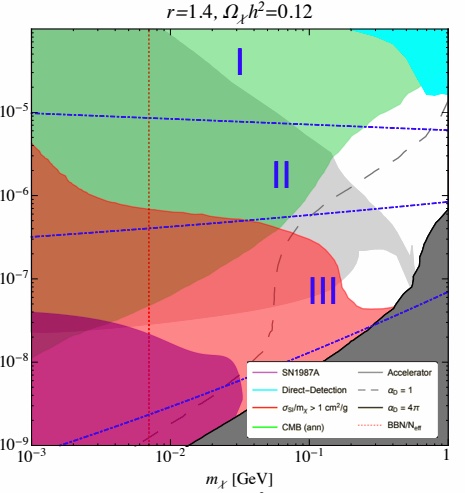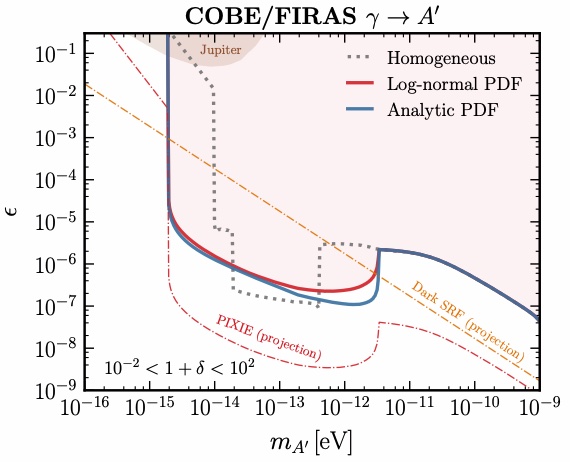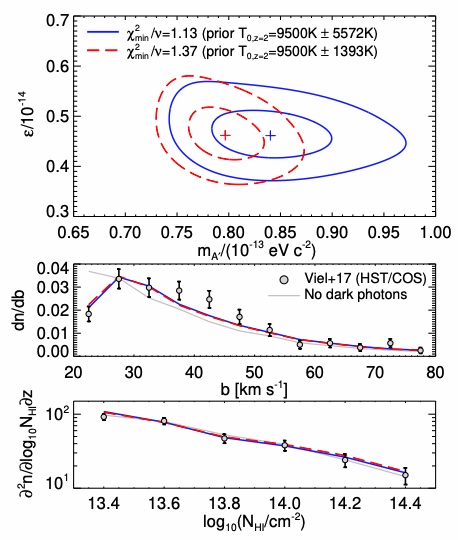Dark Photons
The dark photon—a hypothetical, new particle that could mediate a new force in the dark sector—is an extremely useful paradigm for how new physics, including dark matter, could appear at low energies.
Dark photons are one of only a handful of extensions to the Standard Model that could allow a putative dark matter particle to couple to Standard Model particles through light states.
Dark photons can come in several varieties: 1) massive dark photons, with a mass in the MeV – GeV range; 2) ultralight dark photons, with a mass below an eV, and 3) massless dark photons, which when coupled to a dark matter particle lead to millicharged dark matter. Millicharged dark matter can produce interesting 21-cm signals, and can explain intriguing preliminary data from 21-cm global signal experiments. Dark photons, if they exist, can mix with the Standard Model photon, leading to conversions between dark photons and photons, as well as interactions between Standard Model charged particles and particles in the dark sector.
Dark matter and dark photons in the MeV – GeV range typically require very small mixings between the dark photon and the Standard Model photon for the dark matter to be produced at the right abundance. However, when the dark matter $\chi$ and dark photon $A’$ have a similar mass, with the $A’$ being slightly more massive ($1 \lesssim m_{A’} / m_\chi \lesssim 2$), production of dark matter at the right abundance is possible with couplings that are natural (i.e., close to 1). These well-motivated models of dark matter will be tested at upcoming beam experiments [1–3].

Figure 1. Limits on the dark photon mixing parameter $\epsilon$ as a function of dark matter mass, with a dark photon that is 1.4 times the mass of the dark matter. The open parameter space represents a target for beam experiments to search for this well-motivated model.
Ultralight dark photons lying within the mass range of $10^{-14}$–$10^{-9}$ eV can convert into photons as they propagate through space, and vice-versa. However, the characteristic length over which these conversions occur is much longer than the diameter of the Earth. The best place to look for such conversions is therefore on cosmological scales; the near-vacuum conditions of space also play an important role in allowing resonant conversions between photons and dark photons. These conversions happen many times as they pass through regions of underdensities and overdensities, but can be statistically averaged over the sky using clever analytic results. The disappearance of CMB photons due to their conversion into ultralight dark photons represents one of the best ways to search for the existence of these new particles. If they happen, they would show up as distortions to the CMB spectrum, which has been measured by FIRAS to be a perfect blackbody to very high precision [4, 5].

Figure 2. Conversions of photons into dark photons through cosmic perturbations. Resonant conversion occurs when the mass of the dark photon matches the plasma mass of photons in the presence of baryons, and are marked by the green ticks. Averaging over all paths is possible analytically.

Figure 3. Existing limits on ultralight dark photons as a function of mixing parameter and mass, obtained by looking for distortions in FIRAS data.
If the dark matter is made up of ultralight photons, the same resonant conversion process can convert ultralight dark photon dark matter to regular photons, which are then rapidly absorbed by the gas, heating the gas up. Such energy injection processes leave a strong signal in the Lyman-$\alpha$ forest, a series of absorption lines in the ultraviolet spectra of far-away quasars. In fact, comparison of Lyman-$\alpha$ forest data at different redshifts seem to indicate the presence of a large amount of heating between $z \simeq 2$ and the present day, which can be provided by dark photon dark matter.

Figure 4. Heating from dark photon dark matter can bring Lyman-$\alpha$ data at $z = 0$ (shown in the data points) with theoretical expectations from simulations (shown by the line).
Bibliography
[1] James M. Cline, Hongwan Liu, Tracy R. Slatyer and Wei Xue, “Enabling Forbidden Dark Matter”, PRD 96, 083521 (2017), arXiv:1702.07716
[2] Patrick J. Fitzpatrick, Hongwan Liu, Tracy R. Slatyer and Yu-Dai Tsai, “New Pathways to the Relic Abundance of Vector-Portal Dark Matter”, PRD 106, 083517 (2022), arXiv:2011.01240
[3] Patrick J. Fitzpatrick, Hongwan Liu, Tracy R. Slatyer and Yu-Dai Tsai, “New Thermal Relic Targets for Inelastic Vector-Portal Dark Matter”, PRD 106, 083507 (2022), arXiv:2105.05255
[4] Andrea Caputo, Hongwan Liu, Siddharth Mishra-Sharma and Joshua T. Ruderman, “Dark Photon Oscillations in Our Inhomogeneous Universe”, PRL 125, 221303 (2020), arXiv:2002.05165
[5] Andrea Caputo, Hongwan Liu, Siddharth Mishra-Sharma and Joshua T. Ruderman, “Modeling Dark Photon Oscillations in Our Inhomogeneous Universe”, PRD 102, 103533 (2020), arXiv:2004.06733
[6] James S. Bolton, Andrea Caputo, Hongwan Liu and Matteo Viel, “Comparison of Low-Redshift Lyman-$\alpha$ Forest Observations to Hydrodynamical Simulations with Dark Photon Dark Matter”, PRL 129, 211102 (2022), arXiv:2206.13520